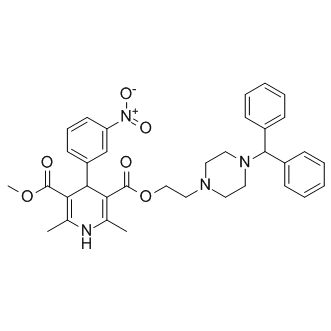All AbMole products are for research use only, cannot be used for human consumption.

Manidipine (Manyper) is a lipophilic, third-generation, highly vasoselective dihydropyridine calcium antagonist with an IC50 of 2.6 nM. It causes systemic vasodilation by inhibiting the voltage-dependent calcium inward currents in smooth muscle cells. It is used clinically as an antihypertensive. At a holding potential of −37 mV, manidipine decreased the Ca2+ current at concentrations above 0.1 nM, and abolished it at 100 nM. The voltage-dependent effect of manidipine on the Ca2+ current may explain the weak negative inotropism of manidipine in ventricular muscles, and provide an electrophysiological basis for its vascular selectivity.
| Cell Experiment | |
|---|---|
| Cell lines | |
| Preparation method | |
| Concentrations | |
| Incubation time | |
| Animal Experiment | |
|---|---|
| Animal models | stroke-prone spontaneously hypertensive rat |
| Formulation | |
| Dosages | 20 mg/kg |
| Administration | oral |
| Molecular Weight | 610.7 |
| Formula | C35H38N4O6 |
| CAS Number | 89226-50-6 |
| Solubility (25°C) | DMSO 100 mg/mL |
| Storage |
Powder -20°C 3 years ; 4°C 2 years In solvent -80°C 6 months ; -20°C 1 month |
| Related Calcium Channel Products |
|---|
| CBD3063
CBD3063 is a selective, first-in-class, CRMP2-based peptidomimetic small molecule, which allosterically regulates Cav2.2 to achieve analgesia and pain relief without negative side effect profiles. |
| TTA-A8
TTA-A8 is a short-acting T-type calcium channel antagonist with oral activity, exhibiting an IC50 value of 31.3 nM in the FLIPR depolarization assay. |
| MONIRO-1
MONIRO-1 is a T-type and N-type calcium channel blocker with IC50 values of 34, 3.3, 1.7 and 7.2 µM against hCav2.2, hCav3.1, hCav3.2 and hCav3.3, respectively. |
| Azumolene
Azumolene (EU4093 free base), a Dantrolene analog, is a muscle relaxant. |
| Nexopamil
Nexopamil is a calcium antagonist of Ca2+ channel, 5HT2, 5HT1A, 5HT1C and dopamine D2 receptors. |
All AbMole products are for research use only, cannot be used for human consumption or veterinary use. We do not provide products or services to individuals. Please comply with the intended use and do not use AbMole products for any other purpose.


Products are for research use only. Not for human use. We do not sell to patients.
© Copyright 2010-2024 AbMole BioScience. All Rights Reserved.
